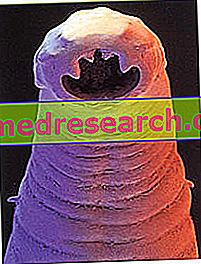The finding of worms in the faeces is a rather disgusting event, but certainly not rare. It is estimated that helminths (as these pests are scientifically called) infect about three billion people in the world. The most common at our latitudes are without doubt the worms of children ( Enterobius vermicularis ), also known as pinworms, whose prevalence in the pediatric age ranges between 30 and 70%. Children are more susceptible to this infestation both due to the immaturity of the defense systems and to the habit of playing with mud and bringing the hands to the mouth without having washed them. In this infestation, the worms in the feces appear as tiny thread-like strips, white and mobile. Females, in fact, measure on average from eight to thirteen millimeters (0.8 - 1.3 cm), while males - smaller - do not exceed 5 mm. Beyond the macroscopic examination of the faeces, the presence of pinworms can be evidenced by a strong nocturnal itching in the anal and perianal region; the females, in fact, migrate from the intestine to this site to lay their eggs. The consequent scratching and the habit of bringing the hands to the mouth, as one can easily guess, favor self infestation.
Analyzing a person's feces, however disgusting it may seem, can help reveal intestinal worms. Not always, however, as in the case of pinworms, parasites have sufficient size to be easily detected by the naked eye. On the other hand, when the size of the worms becomes important, the scenario becomes even more disgusting. The helminths, in fact, have very variable dimensions and in some cases they exceed abundantly the meter in length. This is the case of the tapeworm, a segmented flatworm (cestode), which can reach 8-9 meters. Generally, in this case, the faeces are found not so much the whole worm as some on the white-yellowish segments, similar to small pieces of noodles and defined proglottids. The associated symptomatology may be absent or limited to nausea, disturbance of the alvus and abdominal pain. The main transmission vehicle is represented by the ingestion of raw or undercooked meat infected by larvae.

Ancylostoma duodenale (hookworm)
examined in electron microscopy
to scan.
Other worms of considerable size, called Ascarous ( Ascaris lumbricoides ), determine the most frequent geoelmintiasis in our country. Even in the rest of the world, ascaridiasis is a ubiquitous and rather widespread infestation. The term geoelmentiasis explains the methods of transmission of these organisms; briefly, the man eliminates the eggs in the ground, where they become embryonated and acquire the ability to infest other men. The eggs, therefore, are not immediately infesting like those of the pinworms, but they must spend some time in the ground to "mature". The lack of toilets or the use of black water to irrigate the fields contribute to the spread of infestation, typical - but not exclusive - of rural areas. The female of Ascaris lumbricoides reach a length of 40 cm for a weight of about 9 grams. In addition to the visual verification of these creamy-white or rosy-colored worms in faeces, the ascaridiasis can be characterized by respiratory or gastrointestinal symptoms (depending on the stage of development of the specimens). The first to appear - when the larvae migrate through the lungs - are the respiratory ones, with an irritated cough, wheezing and traces of blood in the sputum. On the intestinal level, on the other hand, the symptoms are often specific or limited, characterized by abdominal cramps, nausea and vomiting. Especially in developing countries, ascaridiasis can cause potentially serious, if not lethal complications.
Other common intestinal worms are the Ancylostoma duodenale and the Necator americanus, responsible for the ankylostomiasis. It is always a geoelmintiasis, in which, however, the larvae - rather than being ingested - penetrate through the skin that makes contact with the contaminated soil. These nematodes, slightly curved, reach a length of 6- 12 mm (0.6 - 1.2 cm). Thanks to the particular buccal apparatus, they anchor themselves firmly to the duoedeno-jejunal mucosa, absorbing considerable amounts of blood. Therefore, the patient may become anemic, showing pallor, weakness, dyspnea and brittle nails.
In the triocefalosi, the parasite ( Trichuris trichiura ) reaches a length of 3-5 cm and resembles a whip, with the thin and cylindrical cephalic extremity, and the posterior stubby and pink.
The finding of a worm in the faeces is certainly not a pleasant experience, but the repercussions on the health of the victim are generally mild. Much worse, for example, being infected by very small organisms, such as some viruses or bacteria. Furthermore, once the parasite has been identified, it is generally possible to eradicate it easily, resorting to a brief pharmacological therapy. Prevention is essentially aimed at complying with the elementary hygiene rules, such as the careful and frequent cleaning of the hands, the careful washing of the raw foods and the generous cooking of the meat (especially the minced pork). Particular caution when going to underdeveloped countries (be careful also to walk barefoot and to the bathroom).



